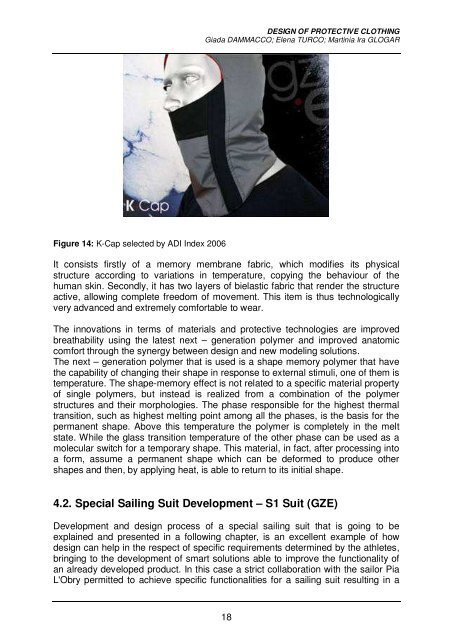Protective Clothing Design - Grado Zero Espace Srl
Protective Clothing Design - Grado Zero Espace Srl
Protective Clothing Design - Grado Zero Espace Srl
Create successful ePaper yourself
Turn your PDF publications into a flip-book with our unique Google optimized e-Paper software.
DESIGN OF PROTECTIVE CLOTHING<br />
Giada DAMMACCO; Elena TURCO; Martinia Ira GLOGAR<br />
Figure 14: K-Cap selected by ADI Index 2006<br />
It consists firstly of a memory membrane fabric, which modifies its physical<br />
structure according to variations in temperature, copying the behaviour of the<br />
human skin. Secondly, it has two layers of bielastic fabric that render the structure<br />
active, allowing complete freedom of movement. This item is thus technologically<br />
very advanced and extremely comfortable to wear.<br />
The innovations in terms of materials and protective technologies are improved<br />
breathability using the latest next – generation polymer and improved anatomic<br />
comfort through the synergy between design and new modeling solutions.<br />
The next – generation polymer that is used is a shape memory polymer that have<br />
the capability of changing their shape in response to external stimuli, one of them is<br />
temperature. The shape-memory effect is not related to a specific material property<br />
of single polymers, but instead is realized from a combination of the polymer<br />
structures and their morphologies. The phase responsible for the highest thermal<br />
transition, such as highest melting point among all the phases, is the basis for the<br />
permanent shape. Above this temperature the polymer is completely in the melt<br />
state. While the glass transition temperature of the other phase can be used as a<br />
molecular switch for a temporary shape. This material, in fact, after processing into<br />
a form, assume a permanent shape which can be deformed to produce other<br />
shapes and then, by applying heat, is able to return to its initial shape.<br />
4.2. Special Sailing Suit Development – S1 Suit (GZE)<br />
Development and design process of a special sailing suit that is going to be<br />
explained and presented in a following chapter, is an excellent example of how<br />
design can help in the respect of specific requirements determined by the athletes,<br />
bringing to the development of smart solutions able to improve the functionality of<br />
an already developed product. In this case a strict collaboration with the sailor Pia<br />
L'Obry permitted to achieve specific functionalities for a sailing suit resulting in a<br />
18
















